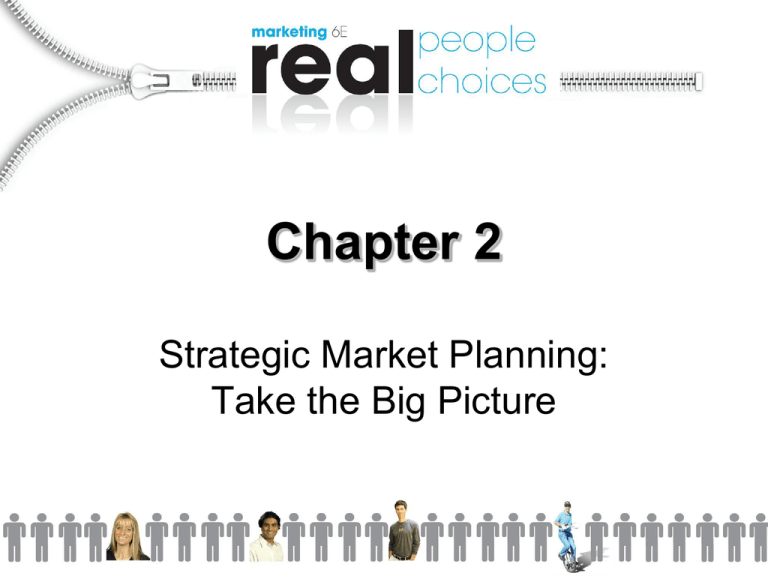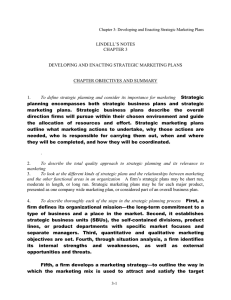Chapter 2 PPTs
advertisement

Chapter 2 Strategic Market Planning: Take the Big Picture Chapter Objectives 1. Explain the strategic planning process 2. Understand the three levels of business planning: strategic, functional and operational 3. Describe the steps in marketing planning 4. Thoroughly discuss key marketing planning concepts: Target Marketing & The Marketing Mix 2-2 Figure 2.1 Levels of Planning in a Company 2-3 Strategic Planning Strategic Planning - Managerial decision process that matches a firm’s resources and capabilities to its market opportunities for longterm growth and survival Top management defines firm’s purpose (mission statement) and objectives Mission Statement Example: MADD: “to stop drunk driving, support the victims of this violent crime, and prevent underage drinking” Objective Example: increase firm’s total revenues by 20% over next five years 2-4 Functional (aka “Tactical”) Planning Accomplished by various functional areas of firm, such as Marketing, HR, Operations, etc Typically includes: A broad 3- 5 year plan to support strategic plan A detailed annual plan Example: marketing plan objective for Ford: The objective for the Ford Focus is to achieve a 10% share of the subcompact market during the 2010 calendar year 2-5 Operational Planning First-line managers focus on day-to-day execution of functional plans Such planning includes detailed annual, semiannual, or quarterly plans Example: an objective may be set in terms of units of a product a particular salesperson needs to sell per month (sales quota) 2-6 All Business Planning Is an Integrated Activity Strategic, functional, and operational plans must work together to benefit the whole firm Marketers must fully understand how they fit with the organization’s direction and resources 2-7 Where the Marketing Planning Process Fits Into overall Company Planning 2-8 Why Write a Marketing Plan? Written marketing plans force companies to have concrete objectives and strategies They provide a reference during the planning period (1 year or several years) to stay on track, get back on track, or get on track They can be shared with key company employees and outsiders to educate them 2-9 Marketing Planning: Step 1 What trends impact the marketing plan for Netflix? 2-10 Step 1 - Perform a situation analysis Builds on SWOT; identifies how the internal and external environments affect the marketing plan Marketing Planning: Step 2 Step 2 - Set marketing objectives Specific to the firm’s brands and other marketing mix-related elements States what the marketing function must accomplish if firm is to achieve its overall business objectives Stated in terms of sales volumes & market share 2-11 Marketing Planning: Step 3 Step 3 - Develop marketing strategies to achieve marketing objectives Marketing strategy: a firm’s overall program for selecting and satisfying their target markets A marketing strategy is aimed at satisfying consumers in the selected target markets through a careful balance of the elements of the Marketing Mix – Product, Price, Place, & Promotion 2-12 Formulating a Marketing Strategy Target Market - Group of people toward whom the firm decides to direct its marketing efforts, by segmenting the market by: Demographics – age, income, gender, etc Psychographics – lifestyle & hobbies Geographics – location of residence Product-related - benefits, usage, loyalty 2-13 Q. What would be a target market for the new Nissan 370Z Convertible using each of these segmentation methods? http://www.theautochannel.com/news/2009/0 6/30/467735.1-lg.jpg Elements of the Marketing Mix Marketing Mix – a strategy is developed for each element of the mix: 1. 2. 3. 4. Product strategy Distribution (Place) strategy Promotion strategy Pricing strategy **The Marketing Mix consists of how the 4 are blended together to fit the needs and preferences of a specific target market 2-14 1. Product Strategy (goods & services) What goods or services to offer Ingredients and features Customer service Package design Brand names Trademarks Warranties Product Positioning – how you want customers to perceive the product 2-15 2. Distribution Strategy Modes of transportation Warehousing Inventory control Order processing Supply channels (retailers, wholesalers, etc) 2-16 3. Promotion Strategy Blending together the various elements of promotion to communicate most effectively with the target market Promotional elements (the Promotion Mix): • Advertising • Sales promotion • Public relations • Direct marketing • Personal selling 2-17 Advertising As a Part of the Pepto-Bismol Promotional Strategy 2-18 4. Pricing Strategy Deals with the methods of setting profitable and justifiable prices Pricing is: Dependent upon competition Based upon supply and demand Closely regulated 2-19 Marketing Planning Step 4: Implement and Control the Marketing Plan Implement = Execute. DO IT! Control - Measuring actual performance, comparing performance to the objectives, and making adjustments where needed Marketing metrics: Return on marketing investment (ROMI) - the revenue generated by investment in a specific marketing program divided by the cost of that program (expenditure) at a given risk level 2-20 Addendum – Strategic Planning The following slides provide more information about Corporate Level Strategic Planning… 2-21 Strategic Planning Step 1: Define the Mission Answer three key questions: 1. What business are we in? 2. What customers should we serve? 3. How do we develop the firm’s capabilities and focus its efforts? Mission statement: A formal document that describes the firm’s overall purpose and what it hopes to achieve in terms of its customers, products, and resources 2-22 Step 2: Evaluate the Internal and External Environments Situational analysis An assessment of a firm’s internal and external environments Internal environment: Controllable elements inside of an organization External environment: Uncontrollable elements outside of an organization that may affect its performance either positively or negatively 2-23 Internal Environment Controllable elements inside a firm that influence how well the firm operates include: People (human capital), physical facilities, financial stability, corporate reputation, quality products, strong brands, technologies, etc. These elements represent key strengths and weaknesses of the firm 2-24 External Environment Elements outside the firm that may affect it either positively or negatively: Economic, competitive, technological, legal/political/ethical, and sociocultural trends Trends manifest as opportunities or threats Firm cannot directly control external factors but can respond to them via planning Visit Trendwatching.com 2-25 SWOT Analysis An analysis of an organization’s strengths (S) and weaknesses (W) and the opportunities (O) and threats (T) in the external environment SWOT enables the firm to develop strategies that maximize strengths and capitalize upon opportunities 2-26 Step 3: Set Organizational or SBU Objectives Very large multiproduct firms may have divisions called strategic business units (SBUs) SBUs operate like separate businesses with their own mission, business objectives, resources, managers, and competitors Strategic planning is done at both the corporate and SBU levels 2-27 Organizational/SBU Objectives Organizational/SBU Objectives: What the firm hopes to accomplish with longrange business plan Need to be specific, measurable, attainable, and sustainable May relate to sales, profitability, product development, market share, productivity, ROI, customer satisfaction, or social responsibility 2-28 Strategic Business Units (SBUs) Large firms like the Walt Disney Company usually operate several SBUs. Disney SBUs include theme parks, movie studios, TV networks, and cruise line 2-29 Figure 2.2 SBUs and the Strategic Plan 2-30 Step 4: Establish the Business Portfolio Business portfolio: The group of different products or brands owned by a firm and having different income-generating and growth capabilities Portfolio analysis: Assessing the potential of a firm’s SBUs Helps make decisions regarding which SBUs should receive more or less of the firm’s resources 2-31 Figure 2.3 Boston Consulting Group (BCG) Matrix 2-32 Step 5: Develop Growth Strategies Product-market growth matrix: Characterizes different growth strategies according to type of market (new vs. existing) and type of product (new vs. existing). Matrix yields four potential strategies: Market penetration Product development Market development Diversification 2-33 Figure 2.4 Product-Market Growth Matrix 2-34











